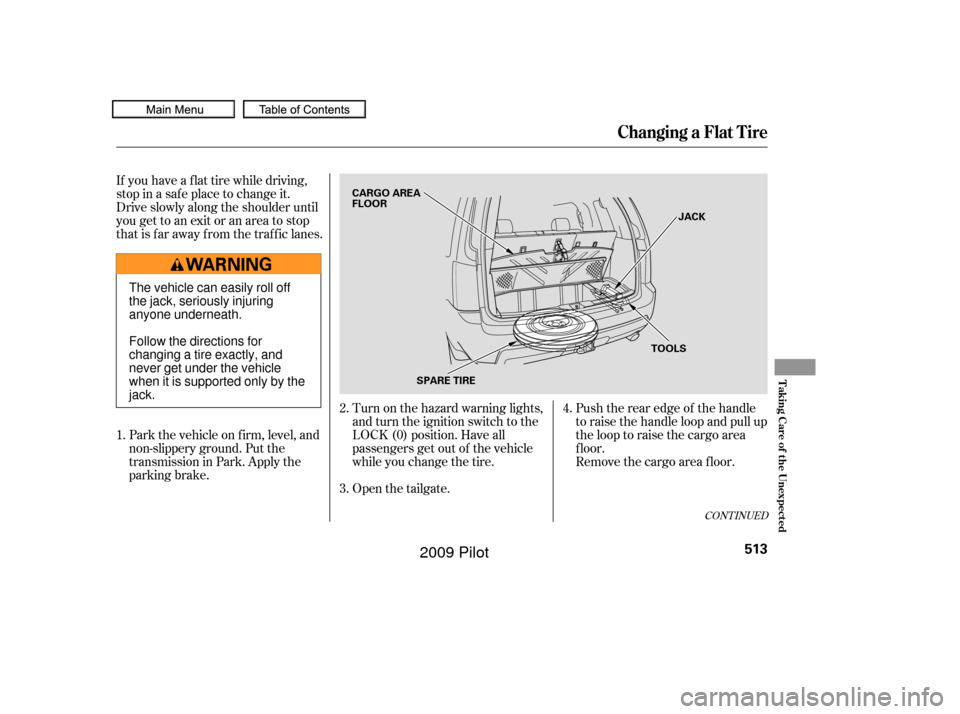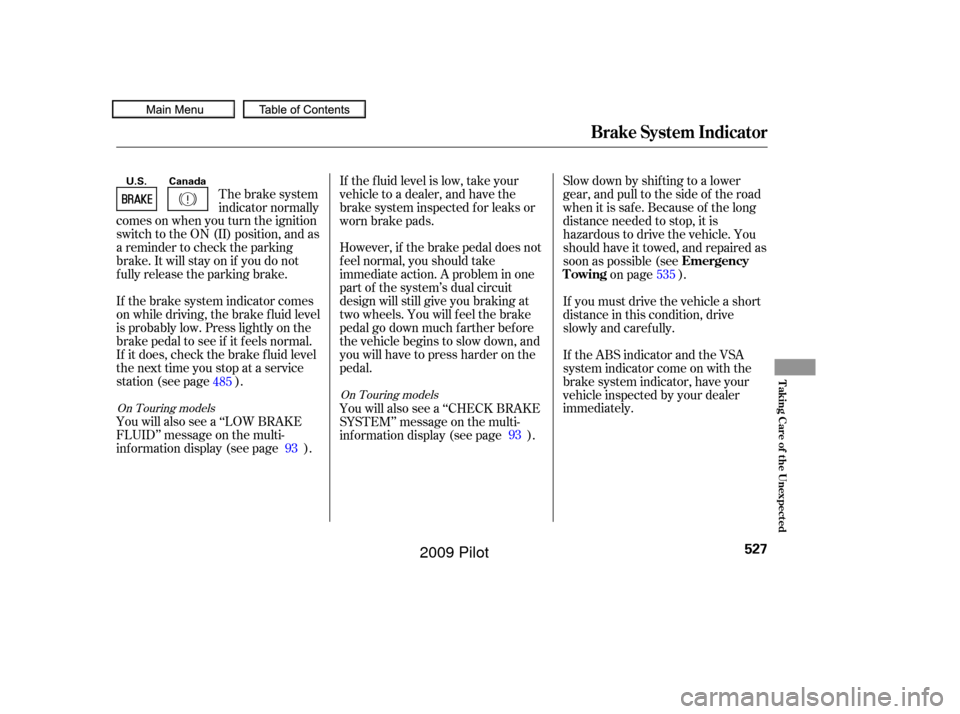Page 517 of 578

If you have a f lat tire while driving,
stop in a saf e place to change it.
Drive slowly along the shoulder until
you get to an exit or an area to stop
that is far away from the traffic lanes.Park the vehicle on f irm, level, and
non-slippery ground. Put the
transmission in Park. Apply the
parking brake. Turn on the hazard warning lights,
and turn the ignition switch to the
LOCK (0) position. Have all
passengers get out of the vehicle
while you change the tire.
Open the tailgate.Push the rear edge of the handle
to raise the handle loop and pull up
the loop to raise the cargo area
f loor.
Remove the cargo area floor.
2.
1.
3.4.
CONT INUED
Changing a Flat Tire
T aking Care of t he Unexpect ed
513
JACK
TOOLS
SPARE TIRE
CARGO AREA
FLOOR
The vehicle can easily roll off
the jack, seriously injuring
anyone underneath.
Follow the directions for
changing a tire exactly, and
never get under the vehicle
when it is supported only by the
jack.
�����—�����—�
���y�
�������������y���
�(�/���������y�����
���y
2009 Pilot
Page 521 of 578
Turn the jack dial (wheel nut
wrench) clockwise as shown to
raise the vehicle until the f lat tire
is of f the ground.Put on the spare tire. Put the
wheel nuts back on f inger-tight,
then tighten them in a crisscross
pattern with the wheel nut wrench
until the wheel is f irmly against
the hub. Do not try to tighten the
wheel nuts f ully.
Lower the vehicle to the ground,
and remove the jack.
Bef ore mounting the spare tire,
wipeanydirtoff themounting
surface of the wheel and hub with
a clean cloth. Wipe the hub
carefully;itmaybehotfrom
driving.
16.
17. 18.
19.
CONT INUED
Changing a Flat Tire
T aking Care of t he Unexpect ed
517
BRAKE HUB
�����—�����—�
���y�
�������������y���
�(�/���������y���������y
2009 Pilot
Page 525 of 578

Are you using the proper starting
procedure? Ref er toon page .
Do you have f uel? Check the f uel
gauge; the warning indicator may
not be working.
There may be an electrical
problem, such as no power to the
f uel pump. Check all the f uses
(see page ).
If youfindnothingwrong,youwill
need a qualif ied technician to f ind
the problem. See on page . Although this seems like a simple
procedure, you should take several
precautions.
You cannot start your vehicle by
pushing or pulling it.
Put the transmission in neutral or
Park, and set the parking brake. Turn of f all the electrical acces-
sories: heater, A/C, climate
control, audio system, lights, etc. Open the hood, and check the
physical condition of the battery.
In very cold weather, check the
condition of the electrolyte. If it
seems slushy or f rozen, do not try
jump starting until it thaws.
1.
2.
415
529 535
CONT INUED
Starting the
Engine
Emergency
Towing Jump Starting
To Jump Start Your Vehicle:
If the Engine Won’t Start, Jump Starting
T aking Care of t he Unexpect ed
521
A battery can explode if you do
not follow the correct procedure,
seriously injuring anyone
nearby.
Keep all sparks, open flames,
and smoking materials away
from the battery.
If a battery sits in extreme cold, the
electrolyte inside can f reeze.
Attempting to jump start with a f rozen
battery can cause it to rupture.
�����—�����—�
���y�
�������������y���
�(�/���������y���������y
2009 Pilot
Page 527 of 578

If you see steam and/or spray
coming f rom under the hood, turn
of f the engine. Wait until you see
no more signs of steam or spray,
then open the hood.
If you do not see steam or spray,
leave the engine running and
watch the temperature gauge. If
the high heat is due to overloading,
the engine should start to cool
down almost immediately. If it
does, wait until the temperature
gauge comes down to the midpoint,
then continue driving.
The pointer of your vehicle’s
temperature gauge should stay in
the midrange under most conditions.
If it climbs to the red mark, you
should determine the reason (hot
day, driving up a steep hill, etc.).
If the vehicle overheats, you should
take immediate action. The only
indication may be the temperature
gauge climbing to or above the red
mark. Or you may see steam or
spray coming f rom under the hood.
Saf ely pull to the side of the road.
Put the transmission in Park, and
set the parking brake. Turn of f all
accessories, and turn on the
hazard warning indicators.
1.
2.
3.
CONT INUED
If theEngineOverheats
T aking Care of t he Unexpect ed
523
Steam and spray from an
overheated engine can
seriously scald you.
Do not open the hood if steam
is coming out.
Driving with the temperature gauge
pointer at the red mark can cause
serious damage to the engine.
�����—�����—�
���y�
�������������y���
�(�/���������y���������y
2009 Pilot
Page 531 of 578

However, if the brake pedal does not
f eel normal, you should take
immediate action. A problem in one
part of the system’s dual circuit
design will still give you braking at
two wheels. You will f eel the brake
pedal go down much f arther bef ore
the vehicle begins to slow down, and
you will have to press harder on the
pedal.
The brake system
indicator normally
comes on when you turn the ignition
switch to the ON (II) position, and as
a reminder to check the parking
brake. It will stay on if you do not
f ully release the parking brake.
If the brake system indicator comes
on while driving, the brake f luid level
is probably low. Press lightly on the
brake pedal to see if it f eels normal.
If it does, check the brake f luid level
thenexttimeyoustopataservice
station (see page ). If the f luid level is low, take your
vehicle to a dealer, and have the
brake system inspected f or leaks or
worn brake pads.
Slow down by shif ting to a lower
gear, and pull to the side of the road
when it is saf e. Because of the long
distance needed to stop, it is
hazardous to drive the vehicle. You
should have it towed, and repaired as
soon as possible (see
on page ).
If you must drive the vehicle a short
distance in this condition, drive
slowly and caref ully.
If the ABS indicator and the VSA
system indicator come on with the
brake system indicator, have your
vehicle inspected by your dealer
immediately.
You will also see a ‘‘LOW BRAKE
FLUID’’ message on the multi-
inf ormation display (see page ). You will also see a ‘‘CHECK BRAKE
SYSTEM’’ message on the multi-
inf ormation display (see page ).
485
93 93535
On Touring models
On Touring models
Emergency
Towing
Brake System Indicator
T aking Care of t he Unexpect ed
527
U.S. Canada
�����—�����—�
���y�
�����������
�y���
�(�/���������y���������y
2009 Pilot
Page 537 of 578
Circuits Protected
Amps.
No.
Circuits Protected
No. Amps. No. Amps. Circuits Protected
Small Light
Stop Lamp
Back Lamp
Turn Lamp, Hazard
20 A
7.5 A
7.5 A
7.5 A
1
2
3
4
Power Tail Gate Motor
VTM-4
Trailer Main
VSA F/S Relay
1
2
3
4 40 A
20 A
30 A
40 A 5
6
7
8
9
10
11
12
13
14
15
16
17
18
19
20
21
22 30 A
30 A
15 A
20 A
20 A
20 A
20 A
15 A
10 A
20 A
20 A
15 A
20 A
15 A
15 A
20 A
15 A
30 A Rear Blower
VSA Motor
Hazard
Power Tail Gate Closer
Driver’s Power Seat
Reclining
Driver’s Power Seat Slide
Stop & Horn
Rear Console Accessory
Socket
Rear Wiper
Trailer E-Brake
A/C Inverter
Center Console Accessory
Socket
Trailer Charge
Front Accessory Socket
Rear Accessory Socket
Glass Hatch Motor
Rear Heated Seat
Head Light Washer Motor
Fuse Locations
T aking Care of t he Unexpect ed
533
SECONDARY UNDER-HOOD FUSE BOX
REAR FUSE BOX
�����—�����—�
���y�
�������������y���
�(�/���������y���������y
2009 Pilot
Page 547 of 578

�Î
�µ
�µ
�µ
�µ
�Î �µ
�µ
�µ
�µ
�µ
�µ
�µ
�µ
�µ
�µ
�µ
�µ
�µ
�µ
�µ
�µ
�µ
Specif ications
Technical Inf ormation
543
Battery Lights
Fuses
Engine
Alignment
Tires
60 W
12 V
12 V 55 W
12 V 8 W
12 V 5 W
8W
5W
1.4 W
3.8 W
12 V
12 V
12 V
12 V 12 V 12 V
28/8 W
5W
12 V 5 W
12 V 18 W 55 W
12 V 60 W
12 V
Capacity 12 V
12 V 60 AH/5 HR
72 AH/20 HR
12 V 21/5 W
12 V 21/5 W
5W
12 V
Headlights
Daytime running lights
Front side marker lights
Front turn signal/
parking lights
Front fog lights
Rear turn signal/tail lights
Stop/Taillights
Rear side marker lights
Backup lights
License plate lights
Individual map lights
Cargo area lights
High mount brake lights
Vanity mirror lights
Door courtesy lights See page
534or the fuse label
attached on the side panel.
See page 533or the fuse label
attached to the inside of the fuse
box lid.
Interior
Rear
Under-hood
See page532and 533or the fuse
box cover.
Type
BorexStroke
Displacement
Compression ratio
Spark plugs Water cooled 4-stroke SOHC i-VTEC
VCM 6-cylinder (V6) gasoline engine 3.50 x 3.66 in (89.0 x 93.0 mm) 212 cu-in (3,471 cm
)
10.5 : 1
SXU22HCR11
ILZKR7B11
Toe-in
Camber
Caster 0.00 in (0.0 mm)
0.08 in (2.0 mm)
0°30’
0°30’
4°12’
Size
Pressure P245/65R17 105T
T165/80D17 104M
32 psi (220 kPa , 2.2 kgf/cm
)
60 psi (420 kPa , 4.2 kgf/cm)
Front/Rear
Spare
Front/Rear
Spare Front
Rear
Front
Rear
Front
Front
Rear
: (H11) (HB3)
(HB3)
DENSO:
NGK:
(H11)
High
Low
Except LX models
�����—�����—�
���y�
�������������y���
�(�/���������y���������y
2009 Pilot
Page 559 of 578
Make sure the vehicle has been
parked with the engine off for 30
minutes.
If the testing f acility determines the
readiness codes are still not set, see
your dealer.
Then drive in city/suburban
traffic for at least 10 minutes.
When traf f ic conditions allow, let
the vehicle coast f or several
seconds without using the
accelerator pedal or the brake
pedal.
Select a nearby lightly traveled
major highway where you can
maintain a speed of 50 to 60 mph
(80to97km/h)foratleast20
minutes. Drive on the highway in
D. Do not use the cruise control.
When traffic allows, drive for 90
seconds without moving the
accelerator pedal. (Vehicle speed
may vary slightly; this is okay.) If
you cannot do this f or a
continuous 90 seconds because of
traf f ic conditions, drive f or at least
30 seconds, then repeat it two
more times (for a total of 90
seconds).
7.
8. 9.
Emissions T esting
Technical Inf ormation
555
�����—�����—�
���y�
������
������y���
�(�/���������y���������y
2009 Pilot